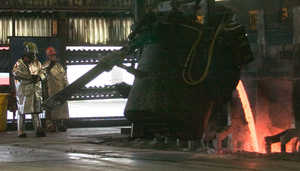forum
library
tutorial
contact

Tentative Power Deal with BPA
Looks Good for Intalco Smelter
by John StarkThe Bellingham Herald, October 31, 2009
|
the film forum library tutorial contact |

|
Tentative Power Deal with BPA
by John Stark |
 A proposed new power deal between Alcoa Inc. and the Bonneville Power Administration could keep the Alcoa Intalco Works aluminum smelter operating for at least another year and a half, preserving as many as 500 local jobs.
A proposed new power deal between Alcoa Inc. and the Bonneville Power Administration could keep the Alcoa Intalco Works aluminum smelter operating for at least another year and a half, preserving as many as 500 local jobs.
Mike Rousseau, Intalco general manager, said the potential deal, announced Friday, Oct. 30, was excellent news for the company, the workers on its payroll, and as many as 1,500 other people whose jobs are indirectly based on Intalco's operations.
But he cautioned that the deal was not yet final, and said previous tentative agreements have fallen apart before they could be completed.
"Lucy's teed the football up for us several times," Rousseau said. "We've had the football pulled away so many times it's hard to get real pumped up about it, but it's a real good deal for us."
Among other things, the deal would guarantee 285 megawatts of power to Intalco for the next 19 months. The smelter now uses 320 megawatts to run two of its three potlines.
Rousseau said the deal also contains provisions that could allow Intalco to get up to 320 megawatts if economic calculations show the deal won't be too costly to BPA.
But as of now, any BPA power deal with Alcoa is on shaky legal ground. Other regional power users have until Nov. 9 to comment on the new proposal.
In the past, some public utility districts have gone to court to challenge BPA's legal authority to provide power to Alcoa. They argue that the public utilities are legally entitled to get preference in the distribution of the region's limited supply of low-priced Columbia River hydroelectric power.
In August, a federal appeals court partially upheld the challengers' legal theory, ruling that any power supply deal between BPA and Alcoa must provide a "net economic benefit" to the region.
During the 19-month term of the latest power deal, BPA would have a chance to get the courts to clarify their interpretation of federal law that governs the agency's power sales to the region.
After that, the proposed deal would enable Alcoa to buy power for an additional five years, if economic conditions warrant, Rousseau said.
Pat Flaherty, representative of the International Association of Machinists and Aerospace Workers Union local that represents Intalco workers, credited strong community support and a strong labor-management relationship for the latest positive news.
"We've been fighting this battle for an awfully long time," Flaherty said. "Union and management work together out here."
Flaherty and Rousseau also credited behind-the-scenes efforts of U.S. sens. Patty Murray and Maria Cantwell, U.S. Rep. Rick Larsen, and Gov. Christine Gregoire in helping to keep BPA receptive to a deal.
But BPA power sales to Alcoa are less popular outside of Whatcom County. That's because BPA doesn't have enough cheap hydropower for all of its customers.
In order to supply power to Intalco, BPA will have to supplement its available supply by purchasing more expensive power, and the cost of that power will be shared by all BPA customers.
An aluminum smelter's appetite for power is enormous. At two-thirds capacity, Intalco uses 320 megawatts of power. That's enough power to light up 320 million 100-watt bulbs, and is roughly equivalent to about one-fourth of the power consumption of the city of Seattle.
Alcoa's opponents claim that over the roughly seven-year life of the proposed BPA-Alcoa deal, other power users would pay an additional $400 million on their electric bills.
Related Sites:
Comment until Nov. 9 at BPA's Web site, www.bpa.gov/corporate.
learn more on topics covered in the film
see the video
read the script
learn the songs
discussion forum
